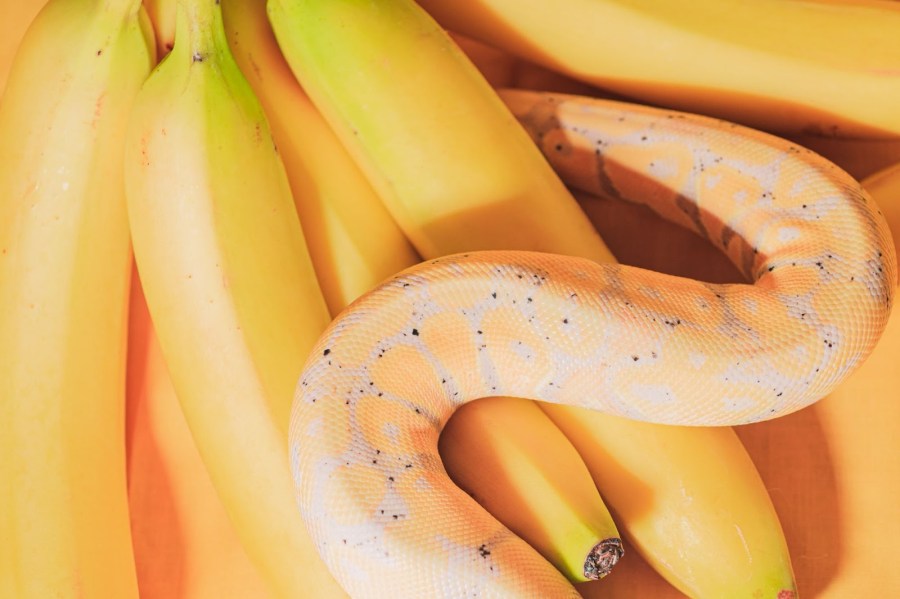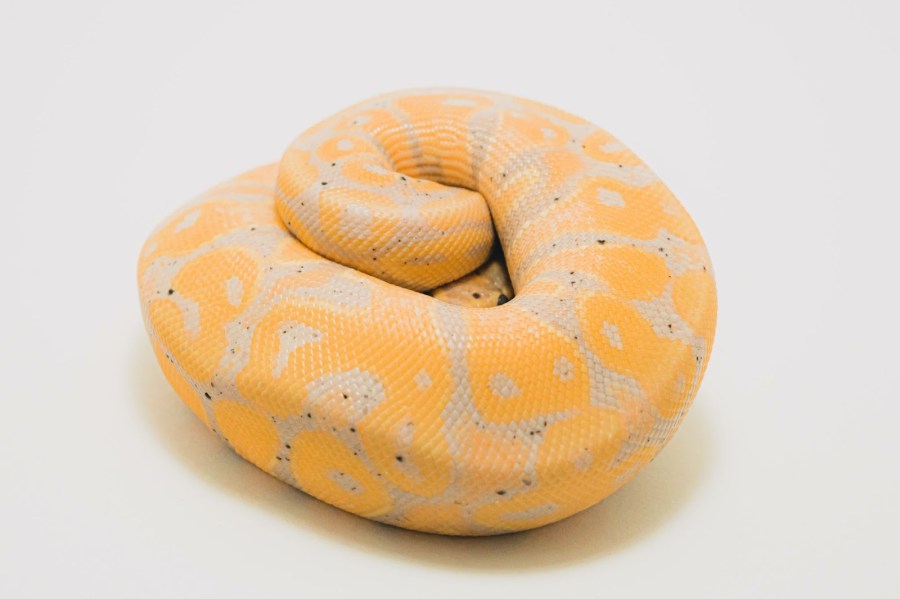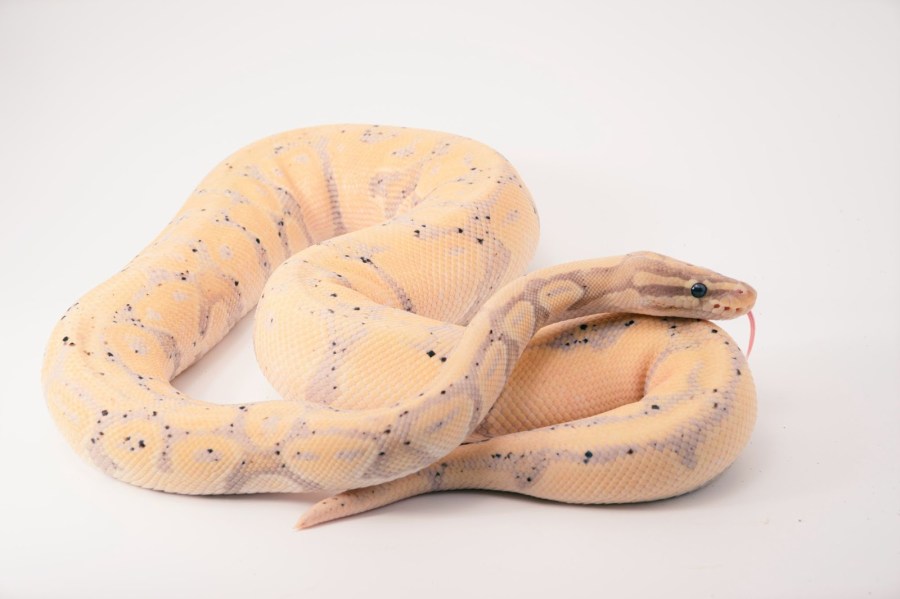How to Feed Live Mice to Ball Python
If you're on the search for a python that's just as beautiful as they are interesting, look no further than the Banana Ball Python. These gorgeous snakes used to be extremely rare, but now they're significantly more common. In fact, they make an excellent beginner pet snake.
If you're considering getting a Banana Ball Python, you probably have a lot of questions–and we're here to help! Today, we're going to share everything you not only want but need to know about these reptiles.
We'll begin by giving you an overview of Banana Ball Pythons. From there, we'll dive into answering the question: do Banana Ball Pythons make for good pets? Then, we'll talk about their dietary habits and, finally, what care you need to give your snake for a long, healthy life.
All About Banana Ball Pythons

As you might have guessed, the Banana Ball Python is a type of ball python snake. It was named for its unique, beautiful pattern. You'll notice that this morph has strong yellow blotches and darker freckles adorning its body. The result is a gorgeous snake that is sure to catch your eye.
These snakes were selectively bred from the West African ball python snake. This produced a gorgeous yellow and tan patterning…hence the name Banana Ball Python.
Despite the fact that these snakes used to sell for several thousand dollars (as high as $25,000 in the early 2000s!), they're much more accessible now. Today, you can purchase a Banana Ball Python for somewhere around $150.
Did you know that the banana morph itself naturally occurred in the wild? It's true! Still, these snakes were specially bred and extremely expensive for a while, as they were a true rarity. Nowadays, the demand is higher–and so are the number of Banana Ball Pythons. That means you can get one for a relatively reasonable price, so don't fret if you don't have $20,000 lying around to spend on a pet snake.
No matter what type of snake that you get, be sure that you acquire one from a reputable breeder that knows what they're doing. It's a good idea to be sure that your snake was bred in captivity and wasn't born in the wild and uprooted from their natural habitat.
There are actually more than 20 different types of banana morphs. They're beloved because of their fun coloration and their easygoing, docile nature. Some of the most popular Banana Ball Pythons include banana spider, clown, cinnamon, pied, and black pastel banana. If you want to know the particular type you're getting, you can ask your breeder directly.
Just like a lot of pythons, the Banana Ball Snake is native to West Africa. In other words, they're certainly used to high temperatures and brief, rainy seasons. And did you know that a lot of West African tribes actually revere the ball python? It's true! These animals are often considered to be symbolic of the Earth. If one is killed, it is given an honorary funeral.

If you're wondering if Banana Ball Pythons make a good pet, we have the answer. While they can make outstanding pets, it's certainly important to do your research before you commit to bringing one home. As with any pet, there are certain families that a Banana Ball Python would be a better fit for, and there are some that might want to reconsider.
We'll start by saying this: these snakes are actually remarkably docile, and not to mention the fact they're easier to handle than a lot of other snakes are. These pythons are constrictors, but they're non-venomous and suffocate their prey–they'll never poison with a bite. Therefore, you don't have to worry about the venom situation.
In addition, we want to note that these snakes are hardy. That means that you can be looking at spending 30 years or more with your Banana Ball Python. Generally speaking, they don't encounter too many health issues. This means that if you give your snake the love and care they need, you can look forward to many years together. Woohoo!
Additionally, Banana Ball Pythons can become afraid if there's a sudden movement. That's why you should be sure that whoever is handling them takes easy, measured actions. This type of snake can learn to enjoy being handled–but it's going to take some time, as well as a willingness to ease your snake into it.
This python will become stressed out if they get handled too much, so resist the temptation to do that. Still, you'll find that this snake is a pleasant addition to your family with their relaxed attitude and easygoing behavior.
What Do Banana Ball Pythons Eat?

So you need to feed your Banana Ball Python. If you have questions about what to feed them, don't worry! We have you covered. The first thing to know is that these animals are actually carnivores. In other words, they'll only consume meat. You'll never be feeding your snake a leafy vegetable–just rodents.
When they're out and about in the wild, these animals slither along the desert floor, searching for mice that they can consume. In captivity, you'll have to provide them with food. You should always make sure that the mouse you're feeding is not too large. It should never be wider than the widest part of your pet snake's body.
It can be tempting to provide your snake with live rodents so they can enjoy the thrill of the hunt. Nevertheless, a feisty mouse can actually harm your snake. It's better to stick to frozen mice that you thaw out prior to feeding time.
When you feed your Banana Ball Python, warm up the rodent to room temperature. For a baby python or juvenile, administer one rodent every five to seven days. For an adult, feed a mouse every seven to ten days. It really is that simple!
Things To Keep In Mind About Feeding Your Snake Rodents
We have some tips and tricks for feeding your pet snake rodents. First, we want to stress the importance of never using your hands. Instead, rely on tongs and gloves. This ensures your snake doesn't nip you during feeding time. It also ensures that you stay protected from the deceased rodent.
Your snake can take a while to eat, so allow them about 12 hours to consume their meal before you take it out of their enclosure. You also must be sure to provide a water bowl. This will have dual use: for drinking and soaking. Be sure it's large enough for the snake to submerge its entire body. Still, it shouldn't be so large that they get stuck. The best option is a shallow, wide bowl. Be sure to refresh this water every day.
What Habitat Do Banana Ball Pythons Need?

You will find that your python is highly adaptable to life in a captive environment. They're not super active, and if you get a tank that's too large for them, they can begin to feel insecure. They're also solitary creatures; don't put two together.
The best decision is to grow your enclosure as the python itself grows. A hatchling can have an enclosure that's just ten to 15 gallons. A juvenile needs one 15-20, and finally, an adult can have a 30-60 gallon enclosure. It should be approximately as long as the adult snake, and the width/height should be a quarter of how long your pet is.
You can use a plastic or glass enclosure, and yes, you will need a basking light. You can also use cypress mulch or orchid bark as a substrate. The most important thing? Good ventilation and a very secure top.
You'll also notice these animals enjoy hiding, so be sure to provide them at least three places to do so. The substrate should also allow for burrowing. It will also help hold humidity, which should be between 50-60%.
It's essential that you heat their enclosure. There are several ways to do this; just make sure your snake can't touch the heat source and burn themselves.
The warmer side of your snake enclosure has to range between 80 and 85 degrees Fahrenheit. By contrast, the cooler should be between 75 and 80 degrees Fahrenheit. Keep digital monitors at both sides to be sure temperatures are correct.
Finally, include a basking spot with an elevated temperature of 88 to 92 degrees Fahrenheit. If you use a basking bulb with UVA light, it can provide valuable sunlight nutrients at the same time.
Lastly, be sure to use a white or clear light during the day and a ceramic heat light during the nighttime hours. This will give your snake a day and night cycle. It should be 12 hours each.
Banana Ball Pythons: An Excellent Pet
As you can see, there are so many reasons why Banana Ball Pythons make fabulous pets. Now that you know how to take care of one, you're prepared to bring yours home.
SOURCE:
Banana Ball Python Care Sheet for First-Time Owners | Everything Reptiles
Snakes of Central and Western Africa | Whitman College
Feeding Snakes Frozen Mice and Other Prey | The Spruce Pets
Source: https://www.reference.com/pets-animals/banana-ball-python?utm_content=params%3Ao%3D740005%26ad%3DdirN%26qo%3DserpIndex&ueid=e3e557a2-4053-4e01-a856-172ab01715bd
Post a Comment for "How to Feed Live Mice to Ball Python"